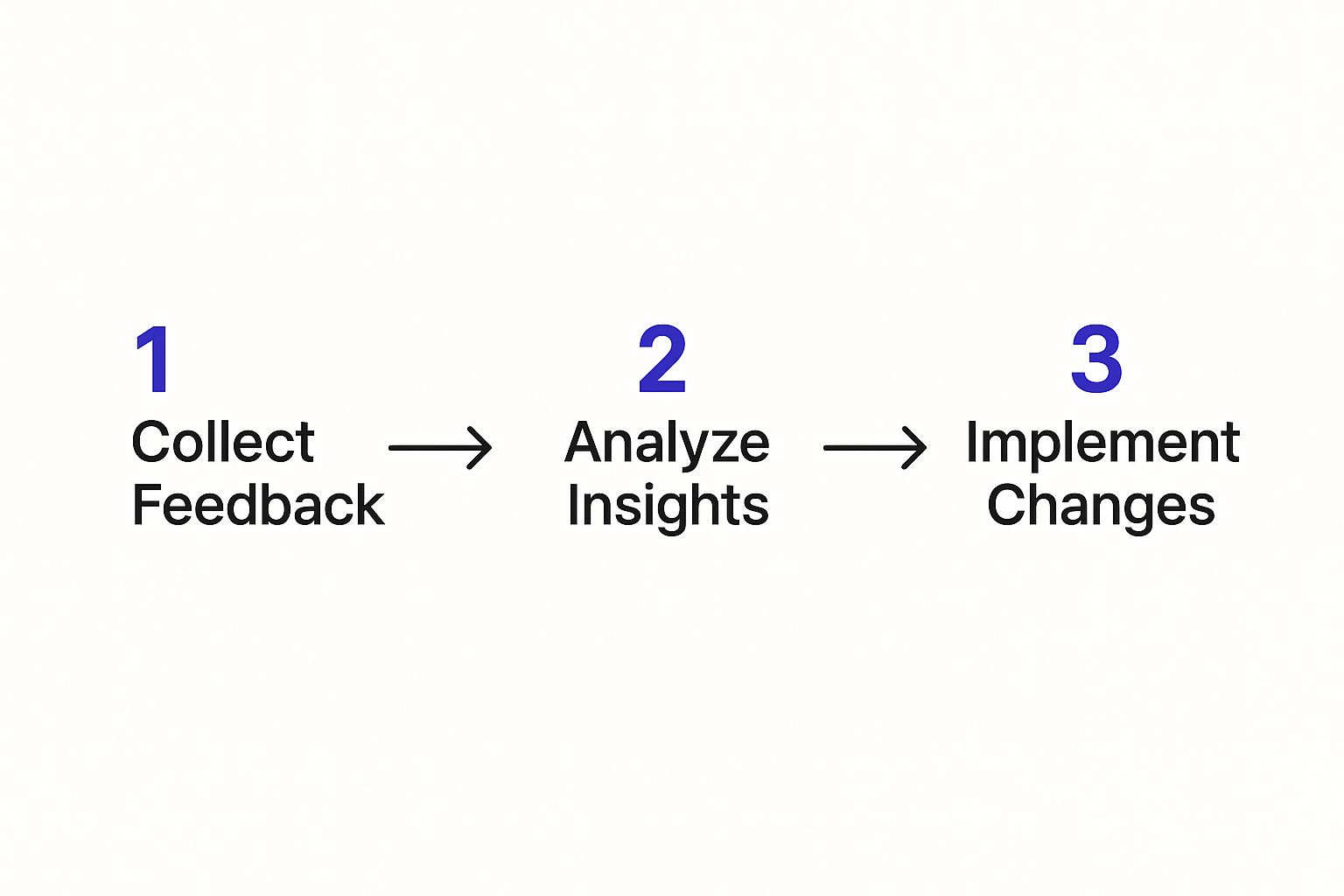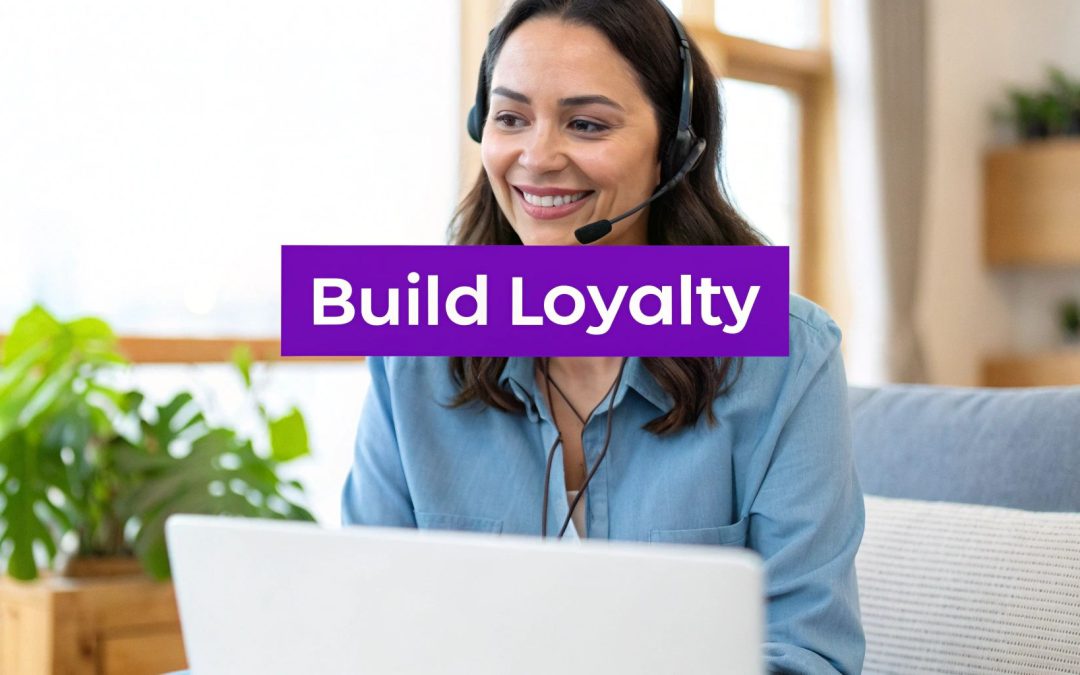For any home service business, building strong customer relationships really comes down to three things: proactive communication, personalized service, and consistent follow-through. If you want sustainable growth and a steady stream of repeat business, you have to shift your focus from simply getting one-off jobs to nurturing long-term partnerships. This all starts the very first time a customer picks up the phone to call you.
The Foundation of Lasting Customer Relationships

In this industry, the real money isn't in a single transaction. It’s earned over time by turning a first-time caller into a loyal advocate for your company. This requires a fundamental change in how you think about your work—moving from just completing a task to actually building a connection.
Think about it. When a potential customer calls, they're probably stressed about a leak, frustrated with a broken AC, or maybe even excited about a new project. That first conversation sets the tone for everything that comes after. You can either treat it as just another lead to close, or you can see it for what it is: the first step in a long-term partnership.
Why a Relational Mindset Matters
A relational strategy is all about understanding the customer's needs beyond the immediate problem. It’s about showing them you're reliable and that you genuinely care, right from the get-go. When a homeowner feels heard and valued, they're far more likely to trust your expertise and call you again next time.
This is exactly where having a professional, dedicated Customer Service Representative (CSR) becomes a game-changer. A well-trained CSR doesn't just book appointments; they build relationships.
A great CSR can:
- Turn an inquiry into a connection: They don't just schedule a time. They listen, empathize, and reassure the customer that help is on the way.
- Set a professional tone: A calm, competent voice on the phone instantly builds confidence in your business.
- Lay the groundwork for loyalty: A positive, stress-free first impression is the foundation of a lasting relationship.
To truly understand this shift, let's look at the two different mindsets side-by-side.
Transactional vs Relational Approach to Customer Service
This table breaks down the difference between a short-term, transactional view and a long-term, relational strategy.
| Focus Area | Transactional Approach | Relational Approach |
|---|---|---|
| Primary Goal | Close the sale; complete the job quickly. | Build trust and solve the customer's problem for good. |
| Communication | Reactive; only what's necessary to schedule. | Proactive; provides updates, reassurance, and education. |
| First Interaction | Get the customer's details and book the call. | Listen to their concerns, empathize, and build rapport. |
| Follow-Up | Minimal; maybe an invoice. | Post-service check-in, maintenance reminders, feedback requests. |
| Success Metric | Number of jobs completed per day. | Customer lifetime value, repeat business, and positive reviews. |
Moving from the left column to the right is how you build a business that lasts. The global Customer Relationship Management (CRM) market’s growth underscores this point. Valued at around USD 73.4 billion a few years ago, it's projected to hit an incredible USD 163.16 billion by 2030. This massive investment proves that businesses everywhere are realizing the immense value of nurturing customer connections.
Key Takeaway: Every interaction, especially the first one, is a chance to prove your business isn't just another service provider, but a trusted partner for your customer's home.
To get this right, you have to master the art of building rapport with customers. This goes way beyond basic politeness—it's about genuine engagement. This is the bedrock of the loyalty and trust that will fuel your business for years to come.
Mastering the First Impression with Expert Communication
That first phone call isn't just a service inquiry; it’s the starting line for your entire customer relationship. How that call goes can mean the difference between landing a loyal, long-term client and losing a lead forever. A professional, empathetic voice on the other end of the line is your single greatest asset in making that initial touchpoint count.
Think about two very different calls your business gets all the time. First, a homeowner in a full-blown panic because a pipe just burst and is flooding their basement. They're stressed, anxious, and need help now. Then, picture another caller, someone casually planning a kitchen remodel for next spring. They’re curious, detail-oriented, and looking for information.
A trained professional knows these are two completely different conversations.
Tailoring Your Approach to the Caller's Needs
The panicked homeowner doesn’t want a sales pitch. They need a calm, confident expert to say, "We can help, and here’s exactly what we're going to do right now." That approach builds instant trust when the pressure is on. The future renovator, on the other hand, needs someone patient who can answer their questions, walk them through options, and schedule a consultation. This shows off your expertise and proves you care about their vision.
Adapting your tone and communication style is everything. It shows you're not just reading from a script but actually listening to their specific situation. This is a core principle of learning how to build customer relationships from the ground up.
Here's a reality check: one study found that while 80% of executives believe their brand is highly trusted, only about 25% of customers actually agree. That massive gap is often created—or closed—during that very first interaction.
Actionable Communication Techniques That Build Trust
Making a customer feel heard and valued isn't rocket science, but it does take intention. It’s about moving beyond simply taking down their name and number.
Here are a few techniques that make a powerful difference:
- Active Listening: This is more than just hearing; it's confirming. For example, "Okay, just to be clear, the water is coming from the pipe under the sink, and you’ve already shut off the main valve? Perfect, that was exactly the right thing to do." This simple step validates their experience and shows you're paying attention.
- Setting Clear Expectations: Never leave a caller hanging. Clearly state what happens next. It could be, "Our technician, James, will be there between 2 PM and 4 PM," or "I'll send you an email right now with our portfolio and some available times for a consultation."
- Ending with Reassurance: Close the conversation with a confident, positive statement. Something like, "Don't worry, we'll get this sorted out for you," or "We're excited to help you bring your project to life" leaves a lasting positive impression.
Never Miss an Opportunity
Every unanswered call is a missed chance to start a new relationship. When a customer needs help, they’ll just move on to the next company on their list. That’s why having a reliable answering service is non-negotiable for any business that wants to grow. It guarantees that every single opportunity—whether it's an emergency or a simple question—is captured by a professional ready to make a stellar first impression.
Going the Extra Mile: How Personalized Service Creates Customers for Life

Let's be honest: generic service is just plain forgettable. A customer might recall that you fixed their furnace, but they won't feel any real connection to your company. It's the personalized touches that stick with people, turning a simple transaction into a memorable experience that builds genuine loyalty.
This isn't just about dropping a customer's name into an email template. Real personalization is about remembering the little things from past conversations and using that knowledge to be thoughtful and proactive. It’s how you turn a one-time job into a long-term relationship.
Turn Every Conversation into an Opportunity
Every time you talk to a customer, you have a chance to learn something valuable. A sharp, well-trained Customer Service Representative (CSR) knows how to listen for those small but crucial details and log them right into your Customer Relationship Management (CRM) system. Suddenly, your CRM isn't just a database; it’s a living playbook for building stronger relationships.
Think about what this looks like in the real world:
- You're a plumber: Your CSR makes a note that Mrs. Gable was worried about her old water heater when you were there to clear a drain. Six months later, your team gives her a call before the first cold snap. "Hi Mrs. Gable, we remember you were concerned about your water heater, and just wanted to offer a free inspection to make sure it's ready for winter."
- You run an HVAC company: During an AC repair, a customer casually mentions his son has bad allergies. Your tech jots that down. The next year, your CSR calls to schedule routine maintenance and suggests an upgraded air filter specifically for allergen reduction.
This is what sets you apart. It shows you're not just there to do a job—you're listening, you're remembering, and you actually care about your customer's home and their family. It’s a powerful way to make someone feel seen and valued.
The takeaway is simple: Personalization isn't a gimmick; it's a core strategy. It proves you see customers as people with unique needs, not just another line item on the schedule.
Proactive Service is the New Standard
Today, we have incredible tools to help us deliver this level of service. Technology, especially AI integrated into CRM software, has completely changed the game over the last decade. The global CRM market was recently valued at a staggering USD 70.2 billion and continues to grow, largely because businesses are using these tools to better understand what their customers really want. You can find more details on the expanding CRM market at factmr.com.
But technology is only half the equation. You need a human touch to bring it all to life. A trained CSR, like those from Phone Staffer, knows exactly what details to capture and how to use them effectively. They can transform a routine follow-up call into a "wow" moment that cements a customer's loyalty, ensuring your company is the first and only one they call next time. It's this blend of smart data and skilled people that creates experiences worth talking about.
The Art of the Follow-Up: Turning a Job into a Relationship
Your technician just pulled away from the curb, and the job is officially complete. Right? Not even close. This is precisely when the real work of building a long-term customer relationship begins. A proactive follow-up strategy is what separates a one-and-done service call from a loyal client who calls you back for years.
The goal is to stay on their radar and genuinely show you care, long after the final invoice has been paid. This simple act transforms a transaction into a partnership. A generic "thank you" email gets deleted in a heartbeat, but a personal call from a friendly voice asking about their experience? That makes an impression.
A Follow-Up Sequence That Actually Works
A great follow-up isn't just one phone call; it's a series of thoughtful touchpoints. When you systematize this process, you guarantee no customer gets forgotten, and every interaction builds more trust.
Here's a proven blueprint we've seen work time and time again for home service businesses:
- The 24-Hour Check-In: Within a day of finishing the job, have someone call just to make sure the customer is 100% satisfied. This shows you stand behind your work and gives you a chance to fix any tiny issues before they snowball.
- The Personal Review Request: Wait a few days, then make a second, quick call. This time, ask if they’d be willing to share their positive experience online. A personal request like this is infinitely more powerful than a bland, automated email link.
- The Smart Maintenance Reminder: This is where you become a true partner. Reaching out proactively for seasonal needs—like an AC tune-up before the first heatwave or a furnace check before winter hits—provides real value. It positions you as a helpful advisor, not just a repair service.
Turning Feedback into Fuel for Your Business
The infographic below lays out a simple but powerful way to use what your customers are telling you to make your business better.

It’s a great reminder that just collecting feedback isn't enough. The real magic happens when you analyze what you've learned and actually make changes based on it.
As you grow, having the right tech to manage these conversations is essential. Just look at the spending on CRM software—large companies account for nearly 74% of all CRM spending. Industries like finance and professional services, which are built entirely on trust, are the biggest investors. This proves that businesses serious about loyalty invest in the tools to manage it. You can see more on these CRM market trends and insights at hginsights.com.
The Bottom Line: A structured follow-up process, especially when handled by professional callers, makes every single customer feel seen and valued. It’s the single best way to secure repeat business and generate powerful word-of-mouth referrals.
Using Technology and People to Scale Relationships

As your home service business grows, you'll inevitably face a tough question: how do you maintain that personal touch when you're juggling more customers than ever before? The answer isn’t a simple choice between tech or people. It’s about blending them into a seamless system.
This powerful combination is exactly how you scale your customer relationships without sacrificing the human element that got you here in the first place.
At the heart of it all is your Customer Relationship Management (CRM) system. Think of a well-kept CRM as the central brain for your entire operation, meticulously tracking every customer interaction, preference, and service history. But a CRM on its own is just a database—it's your team that truly brings that information to life.
The Hybrid Approach in Action
Your CRM is like a detailed map of every customer relationship. It shows you where you've been and helps you chart the best path forward. Your team members are the expert drivers who use that map to create a smooth, personalized journey for each and every customer.
The trick is to create leverage with automation without losing the human touch. Technology provides the scaffolding, but it's your trained, empathetic people who build the actual connection.
For this to work, you have to empower your team with the right tools and training. A skilled Customer Service Representative (CSR) can glance at a CRM profile and instantly elevate the customer’s experience.
- They spot a note about a nervous pet: "When our tech arrives, just let us know a safe spot for Fido, and we'll be extra careful to work around him."
- They see a history of annual maintenance: "Hi, Mrs. Jones! I see you’re calling about your furnace. Since you're part of our loyalty plan, that diagnostic is completely covered."
- They see a previous issue was resolved: "I see we fixed a leaky faucet for you last year. Is everything still working well in the kitchen?"
Mini Case Study: A mid-sized plumbing company in Ohio was drowning in customer data as they grew. They implemented a simple CRM and trained their two CSRs to log detailed notes after every call. Soon, they were making proactive calls for seasonal maintenance based on past service dates. The result? They boosted their repeat business by over 30% in just one year.
Making the System Work for You
The biggest takeaway here is that technology gives you the infrastructure, but people create the memorable moments. A CRM can flag a customer's warranty, but it takes a person to say, "Good news, that repair is fully covered for you."
That simple human touch turns a data point into a moment of genuine relief and connection for the customer.
By equipping a dedicated team—like the remote CSRs from Phone Staffer—with well-organized data, you build a scalable system for outstanding service. For more on this, check out our guide on how to improve call center performance, which gets into the nitty-gritty of optimizing these touchpoints.
This approach ensures that as your business gets bigger, your customer relationships only get stronger.
Your Top Questions About Building Customer Relationships, Answered
Even with the best game plan, I know that building those lasting connections can feel a little tricky. Home service owners I talk to usually have the same questions about making it work on a budget and actually knowing if their efforts are paying off.
Let's dig into some of those common questions and get you some clear, straightforward answers.
Can a Small Business Really Justify a Dedicated CSR?
This is the big one, right? How can a smaller shop possibly afford to have someone dedicated just to answering the phone? The thing is, you have to flip that question around: can you really afford not to?
Think about it. Every single call you miss is a potential job walking out the door. Every time a customer gets a rushed or unprofessional answer, you risk losing them forever. It's a classic case of being penny-wise and pound-foolish.
Seeing a dedicated CSR as just another expense is where many owners go wrong. A great CSR is a profit center. Partnering with a service that provides a virtual CSR is almost always a smarter financial move than hiring someone in-house. You skip the payroll taxes, the benefits, the overhead, and the headache of training, but you get a pro who makes sure every lead is captured and every customer feels like they're your top priority.
What Numbers Should I Actually Be Watching?
Knowing you need to build great relationships is one thing, but how do you measure it? That vague "we give good service" feeling doesn't cut it. You need hard numbers to see what's really connecting with your customers.
Forget the complicated spreadsheets. There are really only three numbers that tell the whole story:
- Repeat Business Rate: This is your north star. What percentage of your customers call you back for their next project? A high number here is the ultimate proof that you’re doing more than just a job—you’re building genuine loyalty.
- Customer Lifetime Value (CLV): This one calculates the total amount of money you can expect to earn from a single customer over the entire time they do business with you. When your CLV is going up, it means your relationships are getting stronger and more profitable.
- Net Promoter Score (NPS): This boils down to one simple but powerful question: "How likely are you to recommend us to a friend or neighbor?" This score directly measures customer advocacy, and it’s one of the best predictors of growth driven by word-of-mouth.
By keeping a close eye on these key metrics, you stop guessing and start knowing. You can see exactly where your efforts are making a real impact and where you might need to adjust your approach.
How Do I Handle Negative Feedback Without Making It Worse?
Look, negative feedback stings. It can feel like a personal attack. But I promise you, it's one of the best gifts you can receive. When you handle a complaint the right way, you can turn an unhappy customer into one of your biggest fans. The secret is having a simple process you follow every single time.
First, just listen. Don't interrupt, don't plan your rebuttal, just let them get it all out. Getting defensive is the fastest way to lose them.
Next, empathize and apologize. Even if you think the issue wasn't your fault, a sincere, "I'm so sorry you had to deal with that," works wonders. It shows you're on their side.
Finally, make it right with a clear solution. This could be anything from a partial refund to sending a tech back out immediately, or maybe a credit toward their next service. When you turn a bad experience into a shockingly positive one, you prove you stand behind your work and truly care. That's how you earn a customer for life.
Ready to build unbreakable customer relationships without the headache of hiring? Phone Staffer can place a trained, professional remote CSR in your business to handle calls, nurture leads, and deliver the exceptional service that creates customers for life. Learn more and get started at Phone Staffer.

